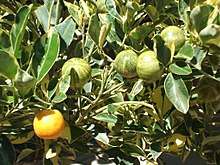Citrofortunella

Citrofortunella are a large group of commercial hybrids that cross the kumquat with other citrus. In the system of citrus taxonomy established by Swingle, kumquats were placed in a different genus, Fortunella, from Citrus, which included citron, mandarin orange, pomelo and papedas. Such hybrids would then represent intergeneric hybrids, and a novel genus name was coined for them in 1975,[1] by making a portmanteau of the names of the contributing genera to form Citrofortunella. That the genus is of a hybrid nature is indicated by a multiplication sign before the genus name, for example × Citrofortunella microcarpa. Recent phylogenetic work has shown kumquats to fall within Citrus rather than representing a distinct genus, meaning these would no longer represent intergeneric hybrids, and use of Citrofortunella as a distinct genus name for these hybrids loses taxonomic validity. They would instead fall within Citrus.[2]
These hybrids combine some of the edibility properties of the more typical Citrus species with the cold hardiness of the kumquats, often being referred to as cold hardy citrus. They produce small acidic fruit and are also more compact than other citrus, making them good ornamental plants.
Of this group, the calamondin has a long history of propagation in Asia as an ornamental plant and food flavoring, but many members of the group are of relatively recent (20th century) generation. These have been given similar common names, portmanteaus that combine the '-quat' ending of kumquat with an indication of the other parent citrus. Some have been assigned separate species names, though there is no agreement on the validity of these names. They can also be represented as a cross between the parent species. The citrofortunella include:
- Calamondin – (tangerine crossed with kumquat)
- Citrangequat – (citrange crossed with kumquat)
- Limequat – Citrofortunella floridana – (Key lime crossed with kumquat)
- Orangequat – Citrofortunella nippon – (satsuma mandarin crossed with kumquat)
- Procimequat – Citrofortunella floridana – (limequat crossed with kumquat)
- Sunquat – (probably Meyer lemon crossed with kumquat)
- Yuzuquat – (yuzu crossed with kumquat)
References
- ↑ Ingram, J.; Moore, H. e. (1976). "Rutaceae". Baileya. 19: 169–171.
- ↑ Mabberley, D. J. (2004). "Citrus (Rutaceae): A Review of Recent Advances in Etymology, Systematics and Medical Applications". Blumea. 49: 481–498.